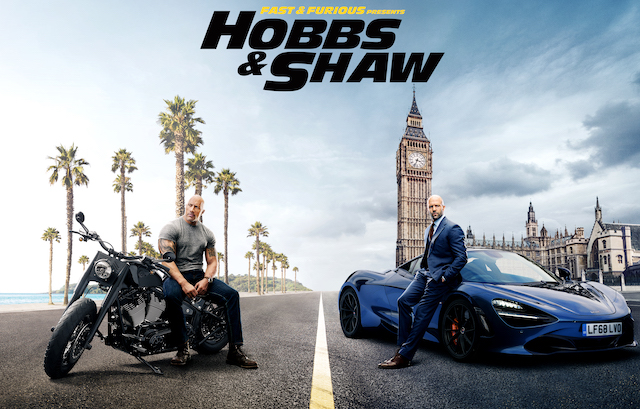Chris Morgan has been a busy writer/ producer during his screenwriting career. Apart from being an integral part of the stratospheric rise of the Fast & Furious franchise, Morgan produced Bird Box, this year’s Netflix mega-hit starring Sandra Bullock. Morgan also wrote on Wanted and Gang Related for Fox Television. He spoke with Creative Screenwriting Magazine to discuss his latest Fast And The Furious spinoff, Fast And The Furious Presents: Hobbs & Shaw.
Chris Morgan has been working to expand the Fast And The Furious world since 2006, when he signed on to the sequel, The Fast And The Furious: Tokyo Drift. Since then, he’s worked on six other films in the franchise and has his name already attached to Fast & Furious 9. But this is no cynical exercise in milking a successful franchise to the extreme. Morgan takes care of his characters and presents them to his audience in an entertaining way.
Fans of the franchise will recognize the character of Luke Hobbs, portrayed by Dwayne “The Rock” Johnson, as he’s been in the narrative since Fast Five in 2011. Likewise, the character of Deckard Shaw, portrayed by Jason Statham, appeared in a cameo back in Fast & Furious 6, but officially joined the cast in Furious 7.

Chris Morgan
The latest installment is directed by David Leitch (Atomic Blonde, Deadpool 2). Chris Morgan shares writing credits with Drew Pearce (Rogue Nation, Hotel Artemis).
“The idea started during Fast 8, specifically when Dwayne and Jason were in opposing prison cells,” joked Chris Morgan. “It was their banter, one-upmanship and talking smack with each other. I remember being there that day and just laughing. So it made sense to take this connection on a journey.”
In terms of story, the narrative for Hobbs & Shaw takes place between Fast and Furious 8 and Fast and Furious 9, which is scheduled for release in 2020. There is no Fast and Furious 8.5 “I’ve always wondered what these guys do between adventures. This is a chance for us to be able to learn more about these characters, what drives them, and their backstories.”
Most spinoffs work to create something stand-alone, but this series is meant to exist in a linear fashion of the total storyline. “We’re in an interconnected world. All the stories should have a sort of ramification. Our characters live full, rich, different lives, where we get to see the different challenges and the different journeys and growth they all have, but at the end, the tone remains the same.”
Chris Morgan started off as a Furious fan. He watched the first two films as an outsider, but felt like he belonged in the universe, as a member of the audience. “If an audience member could transport themselves into that world or into that screen, it feels like those characters would accept you and I genuinely believe that they would. I know their code. I understand their hearts.”
The screenwriter described the Fast and Furious world as a “global culture” of “positivity.” He also stated it’s meant to focus on “heroism” and “family,” which are certainly the core themes of all the films. “I think as long as the world remains true to that in any spinoff, that fabric feels like it is actually one giant piece.”
Modernizing the Franchise
The franchise launched with illegal car races and now it’s more about saving the world from much larger threats. “The Fast franchise is about growth. It is about the characters. We have a lot of trappings of cool cars and giant action globetrotting and all those sorts of things, but at the end of the day, the common denominator among all of these things is these characters that we get to watch grow over a long period of time. We’re very fortunate in that.”
Morgan compared the overall story to an arc in television, where audiences are allowed to watch characters grow across multiple seasons. “You get to run them through various hurdles or challenges in their lives, how they get knocked down, how they overcome. We’ve been very lucky as we’re one of the very few franchises that have allowed us to also create these types of character arcs.”
With this extended timeline, the writers are able to keep the stories fresh because they’re looking at the overall arc of the characters. “It’s just making sure that the challenge of the characters, the hurdle they have to overcome, is something we can recognize in our lives. It’s something we root for our heroes to show us in a heightened way, like a mirror, to tell us to stay strong or grow in our own lives.”

Idris Elba
“The good news is that we get to use different genres to underscore [these challenges.] Fast Five was a heist genre. I hesitate to say sci-fi, but we take a look into the militaristic future in Hobbs and Shaw with Idris Elba’s character Brixton. It highlights the problem in a way that feels ‘of-the-moment’, but at the core, the character growth has to be a universal feeling for the audience.”
“But in the end, we don’t go on the journey just for the stunts. We need to see those characters overcome a personal obstacle. Believe me,” declared Morgan, “I’m the biggest stunt junkie in the world, but as much as I love creative action, those movies don’t mean anything unless they resonate with you on a character level.”
The Writing Process
With Hobbs and Shaw, Chris Morgan has a Story By credit, but also Written by credit. Essentially this involves the expansion of the Fast world. “Since Fast Five – but specifically since Fast 8 – we’ve been thinking about widening and expanding this universe. With that prison sequence in Fast 8, which felt fun and undeniable, and because of these two alpha hero characters who are diametrically opposed to one another, it felt like a great engine.”
While working on Fast 8, Morgan started to bounce ideas off Johnson to come up with a general pitch for what would become Hobbs and Shaw. “In terms of the stories, what growth do we need to see out of these two guys? You have to bring them together with a job they cannot do on their own, but there is something that keeps them together, despite the fact they would love to never see each other again. You have to put a challenge in front of them that is so powerful, it requires that they break down their barriers and agree to work together to overcome the challenge.”
After this initial conversation, the screenwriters spoke with the studio and the various other entities involved with the Fast franchise with a general outline for the story. The first meetings went well, so Morgan was hired to write a script. Specifically, Morgan had ideas for the outline, some big action sequences, and a 3-5 page treatment for pitch meetings.
“I need to know the map of what is the starting point, what’s the destination, and things will change in the middle, but at least I know what I’m always heading towards, pretty extensively. So, we’ll walk everybody through that. And, if everyone agrees, we’ll make changes based on what people are thinking and then the first draft is much easier for me.”
“When we were in pre-production, we brought on David Leitch as a director, who was amazing with action and a great guy. We had a very short pre-production period and a very short production and post-period, trying to make our deliverable date. So we had to be super-efficient. I was producing and writing, so as we got closer, we realized we wanted to make a bigger change and brought in Drew as an extra hand.”
“While I’m writing in certain areas and working with the actors and dealing with a lot of production stuff, he can come in to punch up the script and just keep the train moving forward as quickly as possible.” Drew Pearce is also from the United Kingdom, so he specialized in writing that particular voice for Jason Statham’s character Shaw or Vanessa Kirby’s character, Hattie.

Jane Kirby
Inspired by Action
Morgan is known for his love of Raiders of the Lost Ark, but other films like Butch Cassidy and the Sundance Kid, Star Wars, and movies from the Coen Brothers also helped shape the world of Hobbs and Shaw. “It depends on the scene or sequence, but we’re definitely building on ideas that legends before us built in film history. Some of it is tone and some of it is attitude.”
Morgan thinks of action sequences as mini-movies. Each action sequence requires a clever method to pull off the stunt or event. Then, he considers the sequence in a way that pushes the character through a gauntlet for growth. Then, if the action sequence is missing the character dilemma, it must be revised for growth. “It needs to showcase the character in a new way, but if you can do that while throwing Dwayne Johnson off a building, then all the better.”
The screenwriter compares writing to going to the gym. “It is a slow slog. It is a fight with the page, but once I’m done, I’m so proud and happy that I’ve done it. Then you do it again, and again, and again, on a daily basis. I’m very strong at writing action, but if I had a weaker part, dialogue could probably be the thing I find the most challenging. I spend the most time making dialogue sound natural. I have friends who love writing dialogue, but that’s not me. I’m very envious of that. That’s not my journey.”
Specifically, Morgan’s screenwriting journey consists of visiting coffee shops and bouncing back and forth to the office. He writes everything freehand in a notebook or pad of paper first, as “the computer can sometimes feel paralyzing.” He also tries to listen to the ambient noise of a busy coffee shop or an instrumental soundtrack to help him put words on the page. “The computer actually makes your writing slow down.”
“I’m a fan of film. I worked in a video store for about ten years and I got to hear what people were talking about on a daily basis. Generally speaking, I think it’s moments in movies that move me. I may not remember the entire plot of every movie I’ve seen, but I know the moments. I think the moments that meant something to you filter your writing. You want to evoke something that moves somebody else in that sort of way.”
“Movies moments are those things where they’re so identifiable and heightened that they make you want to cheer or cry or laugh or be terrified. The entire movie doesn’t have to be great, or the entire plot doesn’t have to be the most genius thing in the world, but can you get enough of those movie moments that people leave feeling something special has just happened both outside of them and within them. And, if you do that, it does not matter the genre, whether it is a new or old movie, that’s the magic and that’s what we go for.”
Read our interview with Chris Morgan on The Fate of the Furious HERE.

